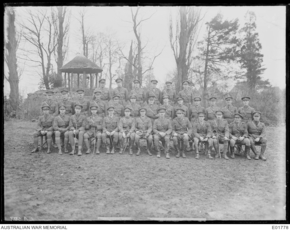DAVISON, Henry
| Service Number: | Officer |
|---|---|
| Enlisted: | 18 June 1915 |
| Last Rank: | Lieutenant |
| Last Unit: | 11th Infantry Battalion |
| Born: | Melbourne, Victoria, Australia, 12 August 1885 |
| Home Town: | Perth, Western Australia |
| Schooling: | Not yet discovered |
| Occupation: | Commercial Traveller |
| Died: | Perth, Western Australia, 23 November 1933, aged 48 years, cause of death not yet discovered |
| Cemetery: |
Karrakatta Cemetery & Crematorium, Western Australia |
| Memorials: |
World War 1 Service
| 18 Jun 1915: | Enlisted AIF WW1, Second Lieutenant, Officer, 11th Infantry Battalion | |
|---|---|---|
| 17 Jan 1916: | Involvement 11th Infantry Battalion, --- :embarkation_roll: roll_number: '10' embarkation_place: Fremantle embarkation_ship: HMAT Borda embarkation_ship_number: A30 public_note: '' | |
| 17 Jan 1916: | Embarked 11th Infantry Battalion, HMAT Borda, Fremantle | |
| 26 Jul 1916: | Wounded AIF WW1, Lieutenant, 11th Infantry Battalion, Battle for Pozières | |
| 3 Jun 1918: | Wounded AIF WW1, Lieutenant, 11th Infantry Battalion |
Help us honour Henry Davison's service by contributing information, stories, and images so that they can be preserved for future generations.
Add my storyBiography contributed by John Baker
Harry Davison was born in Melbourne, Victoria on 12 August 1885. He was the eldest of three boys. In the years preceding the First World War, his mother had relocated from Melbourne to Perth. Her husband had deserted her in 1890. Harry also relocated to Perth to support his mother.
Harry enlisted in Perth as a single man on 18 June 1915, and was assigned to the 13th Reinforcements, 11thBattalion. He listed his profession as a Commercial Traveller.
He completed basic training at Blackboy Hill and qualified as a 2nd Lieutenant on 10 September 1915. On 17 January 1916, he embarked from Fremantle for overseas service on board Borda. He was attached to the 11th Battalion in France on 26 May 1916.
On 22 July 1916, Harry was severely wounded with a bullet wound to the thigh at Pozieres. After a lengthy recovery in England, he was seconded to the 70th Battalion on 20 March 1917, performing Adjutant duties. He was promoted to Lieutenant on 26 August 1916.
On 15 September 1917, he rejoined the 11th Battalion and proceeded overseas to France on 4 February 1918.
Serving with the 11th Battalion, he was again severely wounded on 3 June 1918, with gunshot wounds to the left leg, left arm and left hand. He was invalided to England where he recovered and convalesced until December 1918. He embarked on his return to Australia in October 1919.
Harry is referenced in Bean’s Official History, Volume V, in relation to the Battle of The Lys.
Harry is also mentioned several times in the 11th Battalion's official history, ‘Legs-Eleven’ by Captain Walter Belford. Regrettably, in several references, he is incorrectly referred to as Lieut ‘Davidson’.
This misspelling is something us Davisons are all too used to. Still, it is unfortunate the Battalion’s official history made this mistake regarding one of its own on too many occasions.
One anecdote concerning Harry is recounted in ‘Legs-Eleven’. Around March 1918, he was appointed to lead a raid on an enemy position and accordingly he was training a company of troops behind the lines. Metal breastplates had been issued to the men and Harry was extolling their virtue to a fellow officer, who then asked Harry if he was certain the armour could stop a bullet. Harry enthusiastically replied in the affirmative and with that the questioning officer proceeded to pull out his revolver and shot Harry in the chest at point-blank range. Harry was in enormous pain and ended up with a lump ‘the size of a good-sized pudding bowl’.
A funny story perhaps and I chuckled when I first read it. But on reflection I shudder to think how this prank could have easily gone wrong, not to mention the pain inflicted. The officer in question deserved some of his own medicine. I doubt he would have seen the humour if he was on the receiving end.
Harry’s nickname was ‘Blowfish’. I suspect this may have had something to do with his weight. My father (Harry’s nephew) had a vague childhood memory of meeting his uncle Harry. He recalled he was an ‘enormous man’. Given Harry was only 5’ 6” tall it can only be assumed this recollection of a young boy was in reference to his girth and not his height.
Harry’s youngest brother, Frank Sinclair Davison, died of wounds at Gallipoli on 7 August 1915. He served with the 14th Battalion. Harry’s remaining brother, Jack, was my grandfather and did not serve in the Great War.
Harry died in Perth on 23 November 1933, aged 48. He was buried with his mother at Karrakatta Cemetery. He left a wife and no children.










